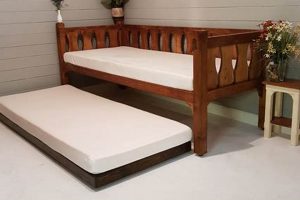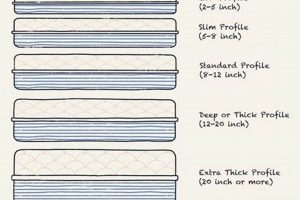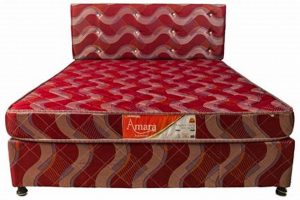Identifying the presence of these pests on a sleeping surface involves a thorough inspection for visual signs, such as live insects, shed skins (exuviae), and dark fecal spots. Careful examination of mattress seams, tufts, and crevices is essential for effective detection. The identification process may also include observing for a characteristic musty odor often associated with infestations.
Early and accurate identification of these unwelcome guests offers significant advantages. Prompt detection minimizes the spread of the infestation, reducing the cost and effort required for effective eradication. Additionally, timely intervention prevents prolonged exposure to bites, which can cause discomfort, allergic reactions, and potential psychological distress. Historically, diligent surveillance has been a key strategy in mitigating the impact of these pests.
The following sections will detail specific methods and techniques for conducting a comprehensive inspection of a mattress, outlining the tools and approaches that contribute to successful identification and subsequent management of any infestation. Understanding the lifecycle and behavior of these pests is also important for complete and appropriate actions.
Detection Strategies
The following tips provide guidance on how to effectively search for these pests on a mattress, enabling early detection and reducing potential infestation impact.
Tip 1: Employ a Bright Light Source: A powerful flashlight or headlamp is crucial for illuminating dark crevices and seams where the pests may be hiding. Direct the light at an angle to reveal shadows and improve visibility.
Tip 2: Utilize a Magnifying Glass: Immature bed bugs (nymphs) are small and difficult to see with the naked eye. A magnifying glass aids in identifying these smaller stages, as well as shed skins and eggs.
Tip 3: Focus on Mattress Seams and Tufts: These areas offer ideal hiding places due to their intricate folds and protective structure. Systematically inspect each seam and tuft, carefully pulling apart fabric to examine hidden areas.
Tip 4: Check the Underside of the Mattress: The underside is often overlooked but can harbor significant infestations. Turn the mattress over and thoroughly inspect the fabric, paying close attention to any tears or imperfections.
Tip 5: Examine the Bed Frame: While the focus is on the mattress, the bed frame itself can also harbor these pests. Inspect joints, screw holes, and any cracks or crevices in the frame.
Tip 6: Look for Fecal Stains: These appear as small, dark spots (often resembling ink) on the mattress or surrounding bedding. They are a common indicator of an infestation.
Tip 7: Be Vigilant for Shed Skins: As bed bugs grow, they shed their exoskeletons. Finding these empty skins is a sign of their presence and activity.
Effective utilization of these strategies increases the likelihood of detecting a bed bug infestation early, allowing for prompt intervention and minimizing the severity of the problem. Early identification through these methods is invaluable.
The subsequent sections will delve into preventative measures and treatment options, ensuring a comprehensive approach to managing bed bug infestations.
1. Visual Inspection
Visual inspection forms the cornerstone of any attempt at discovering the presence of bed bugs on a mattress. It involves a detailed, methodical examination of the mattress and surrounding areas to identify physical evidence of infestation. Its thoroughness directly impacts the success of early detection and subsequent treatment strategies.
- Surface Examination
This entails a close observation of the mattress’s visible surface, paying particular attention to any discoloration, staining, or the presence of live insects. Careful attention to detail is crucial, as bed bugs are adept at concealing themselves. Stains, such as dried blood spots or fecal matter, are indicative of past or present activity. The discovery of live bed bugs immediately confirms an infestation.
- Seam and Crevice Scrutiny
Mattress seams, tufts, and crevices provide ideal hiding places. Inspecting these areas requires the use of a light source and, ideally, a magnifying glass. These hidden spaces offer shelter and protection, increasing the likelihood of finding bed bugs or their eggs. These areas should be gently pulled apart to reveal hidden areas.
- Edge and Corner Focus
The edges and corners of a mattress often accumulate debris and offer easy access points. A thorough inspection of these regions is essential, as bed bugs tend to congregate near feeding sites. These areas also tend to exhibit wear and tear that further allows for the insects to hide.
- Bed Frame Assessment
While the primary focus is the mattress, the bed frame can also provide harborage. The frame itself, especially in the joints, crevices, and screw holes, needs to be examined during the visual inspection. Infestations frequently spread beyond the mattress, rendering inspection of the bed frame a necessary part of the overall strategy.
These facets of visual inspection, when executed with diligence and a keen eye for detail, significantly improve the chances of detecting bed bugs on a mattress. The combination of surface, seam, edge, and bed frame observation offers a comprehensive approach to identifying the physical evidence required for effective pest management. The failure to properly visually inspect will often result in the infestation going unnoticed until it is far more serious.
2. Fecal Spotting
Fecal spotting constitutes a critical indicator in the detection of bed bugs on a mattress. These dark stains, remnants of digested blood, often betray the presence of these nocturnal pests. Understanding their appearance, location, and implications is paramount for accurate identification.
- Appearance Characteristics
Fecal spots typically manifest as small, dark brown or black spots, often resembling the tip of a felt-tip pen. Fresh spots may appear slightly raised or wet, while older spots become dry and may flake off. Their consistency is generally liquid, and they can smear if disturbed. This distinct appearance aids in differentiating them from other types of stains on the mattress.
- Common Locations
Fecal spots are most frequently observed along mattress seams, tufts, and edges areas offering harborage to bed bugs. They may also appear on bedding, such as sheets and pillowcases, particularly in proximity to sleeping individuals. The clustering of spots in these areas suggests a concentrated infestation, facilitating targeted inspection efforts.
- Significa
nce of Spot PatternsThe pattern of fecal spotting can provide clues about the severity and duration of an infestation. Scattered, isolated spots may indicate an early or mild infestation, while dense clusters suggest a more established population. Linear patterns along seams often correlate with the movement and feeding patterns of bed bugs, offering insight into their behavior.
- Distinguishing from Other Stains
Accurately differentiating fecal spots from other common stains, such as food spills or mildew, is essential for avoiding false positives. Fecal spots possess a characteristic dark color and a tendency to wick into fabric, often leaving a distinct ring. Unlike food stains, they lack sugary residue and do not attract other insects. Microscopic examination can definitively confirm their composition.
Recognizing and interpreting the significance of fecal spotting enhances the effectiveness of efforts to determine the presence of these pests on the mattress. By meticulously examining for these telltale signs, individuals can implement targeted strategies for eradication and prevention, safeguarding the sleeping environment.
3. Exuviae Identification
Exuviae, the shed exoskeletons of bed bugs, serve as a crucial indicator in the process of detecting bed bugs on a mattress. As bed bugs mature through various nymphal stages, they molt, leaving behind these translucent, shed skins. The presence of exuviae signals that bed bugs have not only been present but have also been actively developing and feeding in the immediate environment. Discovering exuviae provides confirmation beyond mere sightings of live insects; it establishes a history of infestation. For instance, finding numerous shed skins near mattress seams indicates a sustained breeding ground. Without identifying these cast skins, a partial view of the infestations timeline is obtained, potentially leading to inadequate or mistimed interventions.
The identification of exuviae aids in distinguishing between a current infestation and the remnants of a past one. While fecal spotting and live insects may indicate an ongoing issue, a concentration of exuviae, even in the absence of active bugs, suggests a potentially recurring problem or lingering nymphs yet to mature. Properly recognizing exuviae involves understanding their structure and appearance; they resemble miniature, hollow versions of the bed bugs themselves and are often found in sheltered areas like seams, tufts, and under the mattress. For example, a landlord inspecting a vacated apartment could utilize exuviae as evidence of previous bed bug activity, necessitating preemptive treatment measures before new tenants occupy the space. This understanding is vital for proactive pest management.
In summary, the ability to identify exuviae is an integral skill in the context of detecting bed bugs on a mattress. It provides historical context, differentiates between current and past activity, and informs more effective treatment strategies. Overlooking exuviae can lead to underestimation of the infestation’s scope and longevity, highlighting the necessity of thorough inspection protocols and a comprehensive understanding of bed bug biology.
4. Odor Detection
Odor detection, while not the primary method, provides a supplementary indicator in the process of identifying the presence of bed bugs on a mattress. A heavy infestation can emit a distinct musty, sweetish odor, often described as resembling coriander. This scent arises from pheromones and other volatile organic compounds produced by the insects. The concentration of these compounds increases with the size of the infestation, making the odor more noticeable. For example, a professional pest control operator may use odor detection as a preliminary assessment tool, especially in situations where visual signs are inconclusive or inaccessible, such as within the inner layers of a heavily soiled mattress. The absence of this odor does not preclude an infestation, especially in its early stages; however, its presence warrants further investigation using other methods like visual inspection and the use of interceptor traps.
The reliability of odor detection varies due to several factors, including individual sensitivity, ventilation within the room, and the presence of other competing odors. Individuals with anosmia (loss of smell) or those accustomed to strong scents may not perceive the bed bug odor, even in cases of significant infestation. Conversely, in a well-ventilated room, the odor may be diluted, making it difficult to detect. Real-world examples include scenarios where tenants report a strange odor in their apartments, leading to the discovery of previously undetected infestations. Dog scent detection, a more sophisticated application of odor detection, involves specially trained canines that can identify the scent of bed bugs with greater accuracy and sensitivity than humans. These dogs can pinpoint the source of the odor, even behind walls or under carpeting, providing valuable information for targeted treatment.
In conclusion, odor detection, although subjective and influenced by external factors, offers a valuable supplementary tool in the arsenal for identifying bed bugs on a mattress. Its primary value lies in alerting individuals to the potential presence of an infestation, prompting further, more definitive investigation. The challenges associated with its reliability highlight the need for a multi-faceted approach to bed bug detection, integrating odor assessment with visual inspection and other proven methods. An over reliance on the presence or absence of odor as a sole indicator can lead to both false negatives and false positives, emphasizing the necessity for a balanced and comprehensive detection strategy.
5. Harborage Points
The concept of harborage points is central to effective bed bug detection on mattresses. These are specific areas where bed bugs are most likely to congregate and hide, making them prime locations to target during inspections.
- Mattress Seams and Edges
Seams and edges provide narrow, protected spaces that bed bugs favor. These areas offer concealment and proximity to a blood source, making them ideal for nesting and egg-laying. Real-world examples often reveal clusters of bed bugs and their eggs within these concealed areas. Concentrating inspections on seams and edges significantly improves detection rates.
- Tufts and Indentations
Tufts and indentations create three-dimensional spaces within the mattress fabric, offering additional hiding spots. These areas are often overlooked during cursory inspections. However, thorough examination of each tuft is essential to uncover hidden infestations. In practice, professional pest control services often employ specialized tools to probe and inspect these areas thoroughly.
- Areas Near the Bed Frame Attachments
The points where the mattress meets the bed frame, especially around screws and joints, provide potential access and harborage. These areas offer a pathway for bed bugs to travel between the mattress and the surrounding environment. Neglecting these attachment points can lead to an incomple
te assessment of the infestation, allowing bed bugs to persist even after treatment. - Damaged or Worn Areas of Fabric
Tears, rips, or worn sections of the mattress fabric create additional entry points and hiding places. Bed bugs can readily penetrate these areas, establishing nests within the inner layers of the mattress. Addressing these vulnerabilities, either through repair or mattress replacement, is a critical component of effective bed bug management.
Understanding and targeting these harborage points is a key element in the process of detecting bed bugs on a mattress. By systematically inspecting these areas, individuals and professionals can increase the likelihood of early detection and implement targeted control measures, minimizing the impact of the infestation.
Frequently Asked Questions
The following questions and answers address common concerns and provide clarification on the subject of detecting bed bugs on mattresses. The information is designed to offer a comprehensive understanding of the detection process and related aspects.
Question 1: What is the earliest sign that might indicate bed bugs on a mattress?
Small blood stains on bedding, often referred to as fecal spots, may be among the first indicators. These spots, typically dark in color, are found near seams and edges where the insects often harbor.
Question 2: Is a musty odor always present with a bed bug infestation?
A distinct musty or sweetish odor, sometimes likened to coriander, is associated with heavy infestations. However, early or light infestations may not produce a noticeable odor, making odor detection unreliable as a primary indicator.
Question 3: Can bed bugs infest only the mattress, or do they spread elsewhere?
While mattresses are a primary harborage site, bed bugs can spread to other areas, including bed frames, headboards, nearby furniture, and even walls and carpeting. A comprehensive inspection should extend beyond the mattress.
Question 4: Are bed bug bites necessary to confirm their presence on a mattress?
Bites can be an indicator, but they are not definitive. Many individuals do not react to bed bug bites, and other insects can cause similar skin irritations. Visual confirmation of the insects or their signs is required for definitive confirmation.
Question 5: What tools are most effective for detecting bed bugs on a mattress?
A bright flashlight, a magnifying glass, and a stiff-bristled brush are effective tools for inspecting mattresses. These tools aid in illuminating and accessing concealed areas where bed bugs may hide.
Question 6: Should a mattress encasement be used even if no bed bugs are detected?
A mattress encasement can serve as a preventative measure, creating a barrier that prevents bed bugs from infesting the mattress. It also makes detection easier by limiting harborage points.
In conclusion, thorough and systematic inspection techniques are crucial for accurate detection of bed bugs on mattresses. Reliance on a single indicator or detection method is discouraged; a multi-faceted approach ensures a more reliable assessment.
The following section will address preventative measures to minimize the risk of bed bug infestations in the home.
Conclusion
The process of detecting bed bugs on a mattress necessitates a methodical approach, combining visual inspection, identification of fecal matter and exuviae, odor assessment, and targeted examination of harborage points. Consistent diligence in these methods is paramount for effective detection.
Given the potential health and economic impacts associated with infestations, regular and thorough monitoring is highly advisable. Proactive strategies and prompt action upon discovery will significantly mitigate the potential negative consequences and promote a healthy sleeping environment.


![Best Folding Murphy Bed Mattress [Guide & Reviews] Organic & Natural Mattress Buyer’s Guide: Non-Toxic Sleep Solutions Best Folding Murphy Bed Mattress [Guide & Reviews] | Organic & Natural Mattress Buyer’s Guide: Non-Toxic Sleep Solutions](https://mattressworldpa.com/wp-content/uploads/2025/07/th-7105-300x200.jpg)
![The Ultimate King Size Beds with Mattress [Guide] Organic & Natural Mattress Buyer’s Guide: Non-Toxic Sleep Solutions The Ultimate King Size Beds with Mattress [Guide] | Organic & Natural Mattress Buyer’s Guide: Non-Toxic Sleep Solutions](https://mattressworldpa.com/wp-content/uploads/2025/07/th-7104-300x200.jpg)


![Best Bed Car Mattress [Guide] Mobile Beds For Cars Organic & Natural Mattress Buyer’s Guide: Non-Toxic Sleep Solutions Best Bed Car Mattress [Guide] Mobile Beds For Cars | Organic & Natural Mattress Buyer’s Guide: Non-Toxic Sleep Solutions](https://mattressworldpa.com/wp-content/uploads/2025/07/th-7101-300x200.jpg)
